Sight In Your Target With These Expert-Recommended Range Finders
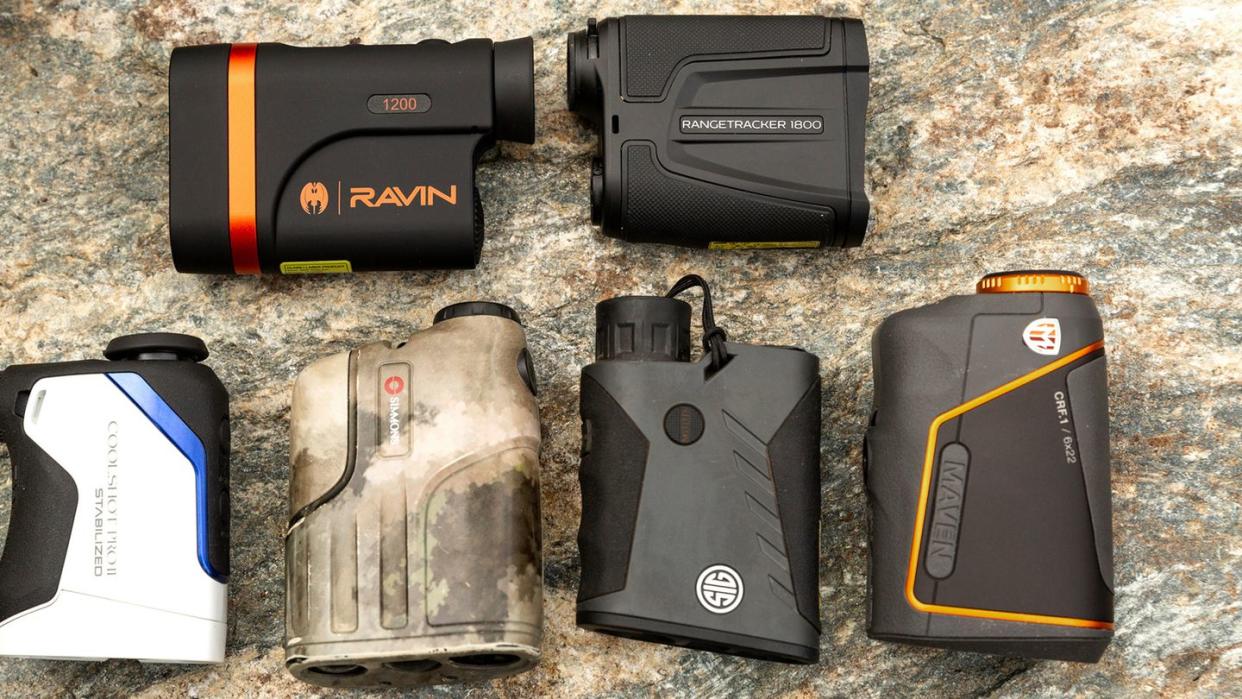
"Hearst Magazines and Yahoo may earn commission or revenue on some items through these links."
Whether you’re hunting big game or trying to chip onto the green, a range finder is essential equipment for accurately gauging distance outdoors. While you can certainly get better at eyeballing distances, the reality is that trees, open space, and other objects can easily trick your senses.
Laser range finders are not so easily fooled, and they provide a quick and easy way to confirm those distances: simply look through the monocular, aim, click a button, and get a distance reading.
While all range finders have the same basic purpose, the details that matter most—like maximum ranging distance—will depend on the sport and how you’re using it in the field. I’ve organized my favorites below in categories to help you find the range finder that’s right for you.
The Best Range Finders
Best Overall: Maven CRF.1 Hunting Rangefinder
Best Budget: Bushnell BoneCollector 1000 Rangefinder
Best High-End: Maven RF.1 Rangefinder
Most Compact: GPO USA RangeTracker 1800 Rangefinder
Best for Golf: Nikon COOLSHOT ProII Stabilized Rangefinder
The Expert: I grew up eyeballing shot distances on whitetail deer in Upstate New York, but a few misses taught me the value of a good rangefinder, especially when I began archery hunting. Now based in Colorado’s Rocky Mountains, I chase mule deer, elk, pronghorn, and bighorn sheep, and my reliance on rangefinders to ensure an effective, ethical shot with either bow or rifle is even stronger today.
What to Consider in a Range Finder
Magnification
Range finders usually feature a small amount of magnification: between about 5x and 10x. Being zoomed in a bit makes it easier to range a specific target in your field of view, which might be more than a mile away. It also makes it easier to transition from binoculars to range finder since binoculars are likely somewhere in the 8x to 18x range of magnification.
If you hunt only densely treed areas such as Eastern hardwood forests, a decent range finder may allow you to leave the binoculars at home. The same could be said for most riflescopes, but it’s not a good idea to use a firearm’s optics to scan an area for hopefully obvious reasons, so a range finder makes a better alternative.
Eye These Up, Too: Best Night-Vision Goggles • Best Binoculars • Best Telescopes
Objective Lens Diameter
The viewing scope of the range finder is monocular like a telescope or spotting scope but with a smaller objective lens. An objective lens diameter is basically the size of the viewing field created by the exit lens on your range finder. Most range finders fall in the 20- to 25-millimeter range. For comparison, most binoculars have 40- to 50-millimeter objective lenses and spotting scopes will be 50- to 100-millimeters.
While you might think it would be difficult to look one-eyed through an objective lens as small as those on range finders, the small form factor (most are designed to fit comfortably in one hand) makes them easier to keep steady for quick target acquisition. For longer distances, a tripod may be required to ensure effective, accurate ranging; higher-end range finders that can range more than a mile usually have a standard ¼-inch tripod mounting-plate hole.
Maximum Range Capability
The stat that most shoppers searching for a range finder focus on is the maximum distance a given range finder can accurately detect. The number listed by companies is often a best-case-scenario number based on the device’s ability to get a reading from a large, bright, reflective surface. Nonreflective items in the field, such as trees and smaller items like game and putting-green flags, are much harder to range accurately for these laser devices.
While price and performance often improve with rated distance, more is not always better. Keep in mind the distances you will most often be ranging and try to pick a range finder that’s suited to the task—ideally one created specifically for whatever it is that’s brought you here to look for a range finder.
For example, most golfers can’t drive the ball farther than 300 yards, so there’s not much use in paying for a golf range finder that can range out to 4,000 yards. Likewise most archery hunters don’t take shots beyond 70 yards (and most much less than that), so they are mostly ranging distances within a few hundred yards at most when deciding on whether to take a shot.
It’s worth pointing out that most hunters aren’t capable of taking an ethical shot on an animal beyond 500 yards, and even the best long-range hunters with the best equipment are limited by ballistics to a little over 1,000 yards. Which begs the question: Why do you need a range finder that can give you distances upward of 4,000 yards?
While range finders certainly are most important when preparing for a shot, hunters also use them to gauge distances. You might not shoot at the elk you see 2,000 yards across the valley, but it’s helpful to know how much distance you need to cover to get into shooting range.
How We Selected These Rangefinders
My picks are based on conversations with optics brand representatives, shop owners, hunters and golfers, as well as salespeople in big-chain outdoors stores. I've used about a dozen range finders—from the cheapest you can get to the top-of-the-line—in the field hunting both archery and rifle big game season. I tested several of the range finders recommended below hands-on to compare performance side-by-side and in real-world conditions. These are the rangefinders worth your money.
CRF.1 Hunting Rangefinder
Most rifle hunters want a rangefinder that’s easy to use and works when they need it to—at mostly modest distances. For hunters who aren’t shooting beyond 500 yards, a 1,000-yard capable range finder is plenty but sometimes you want to be able to range longer distances, even if you aren’t shooting across them.
Maven’s CRF.1 will let you range out to 2,400 yards on reflective objects and trees up to 1,300 yards which means you can gauge distances over a mile away while getting specific shooting distances on an animal up to 650 yards away.
Maven’s direct-to-consumer model has always delivered high-quality optics for less, but the brand's C series, which includes this CRF.1 model, offers cheaper options to reach a wider audience.
I have tested both the CRF.1 and the company’s higher-end RF.1 rangefinder (included in this roundup as well), and prefer the cheaper CRF.1. The effective range is shorter but you save $150 and the clarity of view is still incredible for the price. The CRF.1 also has a slimmer profile than the RF.1 thanks to the omission of the large alloy button that sticks out from the RF.1.
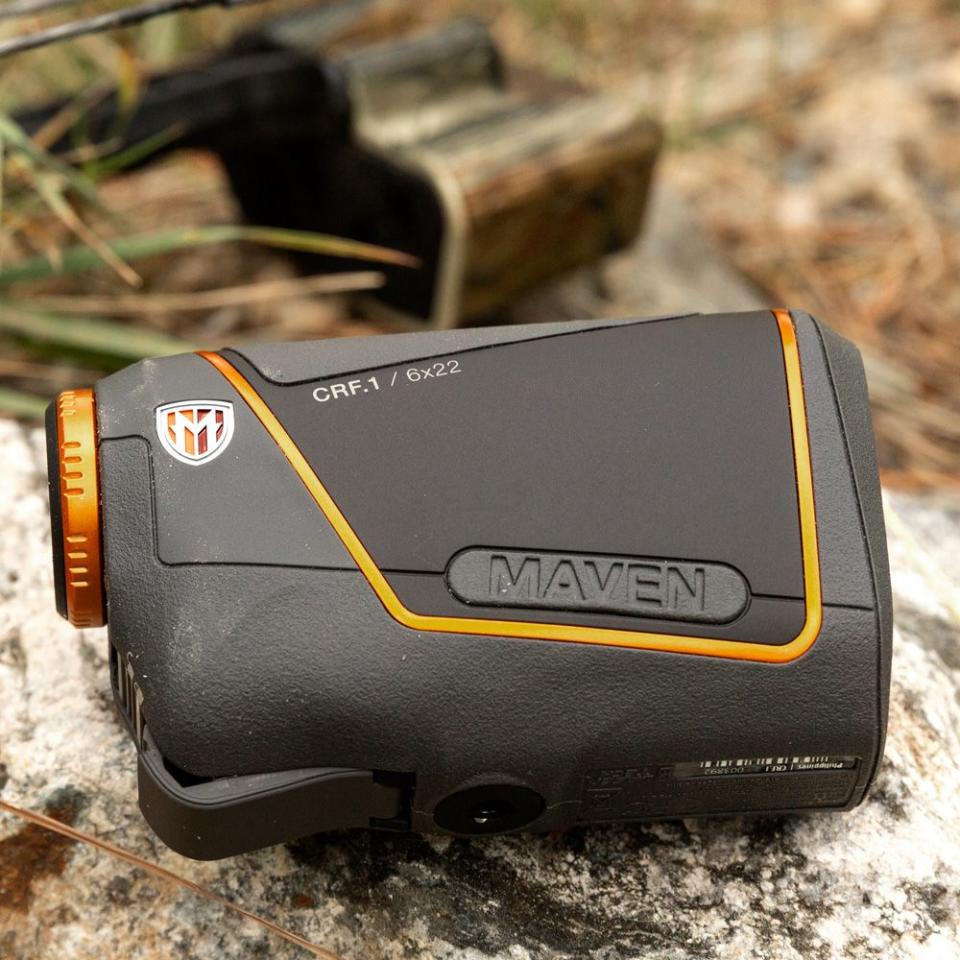
CRF.1 Hunting Rangefinder
amazon.com
$295.00
Justin ParkBoneCollector 1000 Rangefinder
By the time a hunter pays for firearms and bows, clothing, binoculars, and all the accessories pitched as essential these days, it’s not surprising they hardly feel like forking over several hundred dollars more for a range finder. The Bone Collector 1000 from Bushnell isn’t the cheapest range finder you can buy, but it’s the cheapest one I recommend.
The simple one-button operation and generous 25-millimeter objective lens make it easy to use for targets such as deer out to 350 yards, which is pushing the limits of your average hunter anyway. (Reflective targets can be measured out to 1,000 yards so this won’t limit you to 350 in most situations if you can range a nearby object.)
The 1000 is essentially a replacement for the BoneCollector 850, which I recommended as a budget option in the past. This new model adds angle compensation for archery hunters, expands the viewing area a bit, and extends the range yet keeps the modest price about the same, making this an even better value than its predecessor.
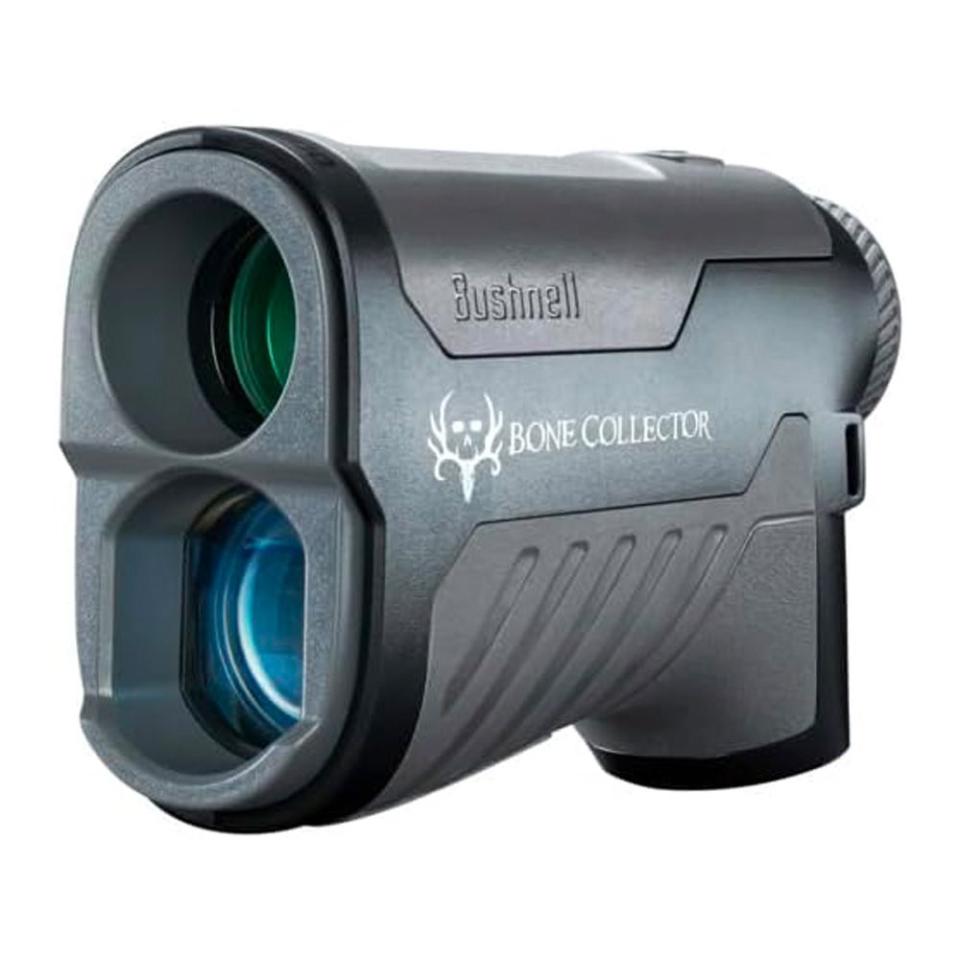
BoneCollector 1000 Rangefinder
amazon.com
$149.99
RF.1 Rangefinder
The RF.1 was Maven’s first range finder—and it’s a good one. Its direct-to-consumer business model keeps the top-of-the-line performance under $500 while offering unique features and, most important, high-quality Japanese glass that makes viewing far-off targets through the large 25-millimeter lens a pleasure. There’s also an unconditional lifetime warranty.
The red LED overlay is easy to read and the menu and modes are simple to navigate without consulting a manual, but there are some advanced features such as Field and Forest modes, which help improve accuracy based on the environment you’re hunting.
The 4,500-yard maximum range is about as good as it gets and should be more than enough for even the most demanding long-range shooter. If you don’t need the very best and want to save some cash, look at their newer, more affordable CRF.1 recommended above, our Best Overall.
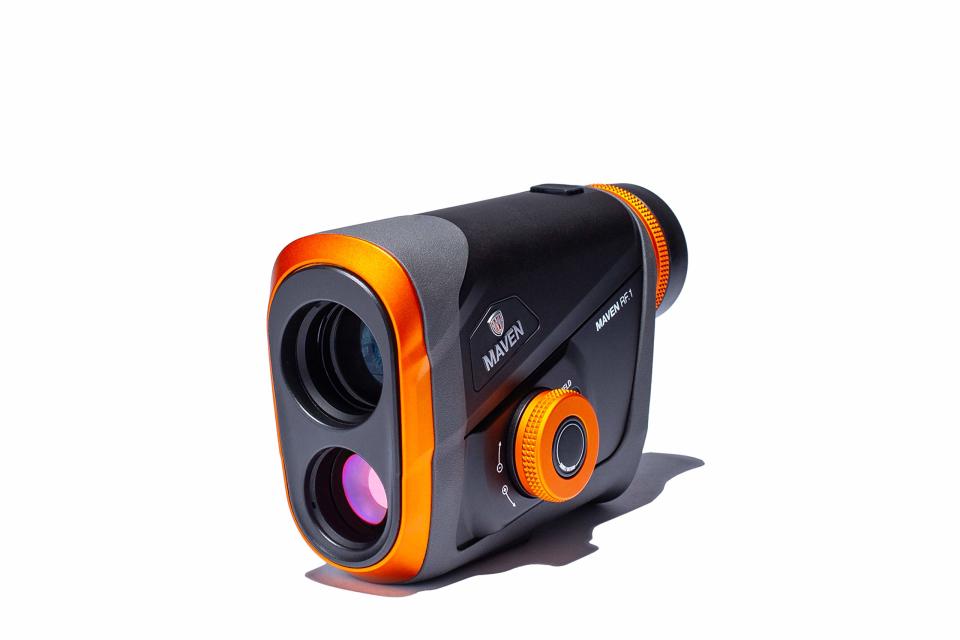
RF.1 Rangefinder
amazon.com
$450.00
USA RangeTracker 1800 Rangefinder
While cheaper range finders usually aren’t particularly heavy, they can be bulky, which can be annoying when trying to quickly get them in and out of a pocket or holster when it counts.
German Precision Optics is actually an American company using European glass, and this compact unit delivers exceptional clarity in a tiny, streamlined package. I found the finder easy to move in and out of my chest harness’ range finder compartment.
In addition to the clear picture, the specs are solid, with the 1,800-yard maximum range, angle compensation, scan mode, and even a temperature read-out. The price tag is on the high side thanks to the quality glass and design, but it’s worth paying if you want a compact unit that doesn’t skimp on performance and features.
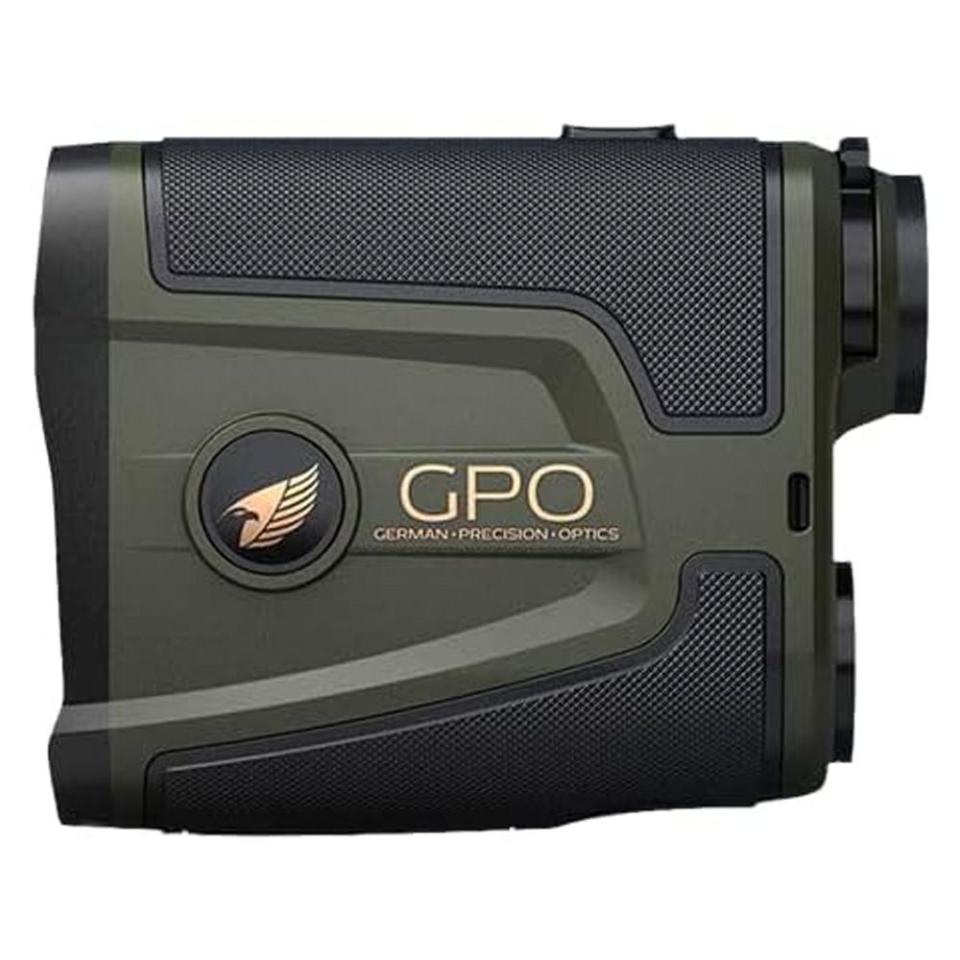
USA RangeTracker 1800 Rangefinder
amazon.com
$389.00
COOLSHOT ProII Stabilized Rangefinder
Given the relatively short distances measured in golfing, any decent range finder will be adequate for estimating most distances on the golf course. However, this golf-specific model from Nikon has a host of features that make it enjoyable for use on the links. One of these is the new stabilization feature that helps you lock in on your target to be sure you’re getting an accurate reading to the pin and not the sand trap behind it.
Like many hunting range finders, it also has slope-angle compensation which helps adjust your shot for uphill and downhill holes. This isn’t a cheap option, but thanks to the extremely clear Nikon glass and the stabilization feature, this rangefinder is a joy to use compared to cheaper options.
If you want something with great clarity but that is a bit more affordable, Cobalt’s Q-4 is essentially a golf-specific version of the range finder I recommended as Best Overall above.
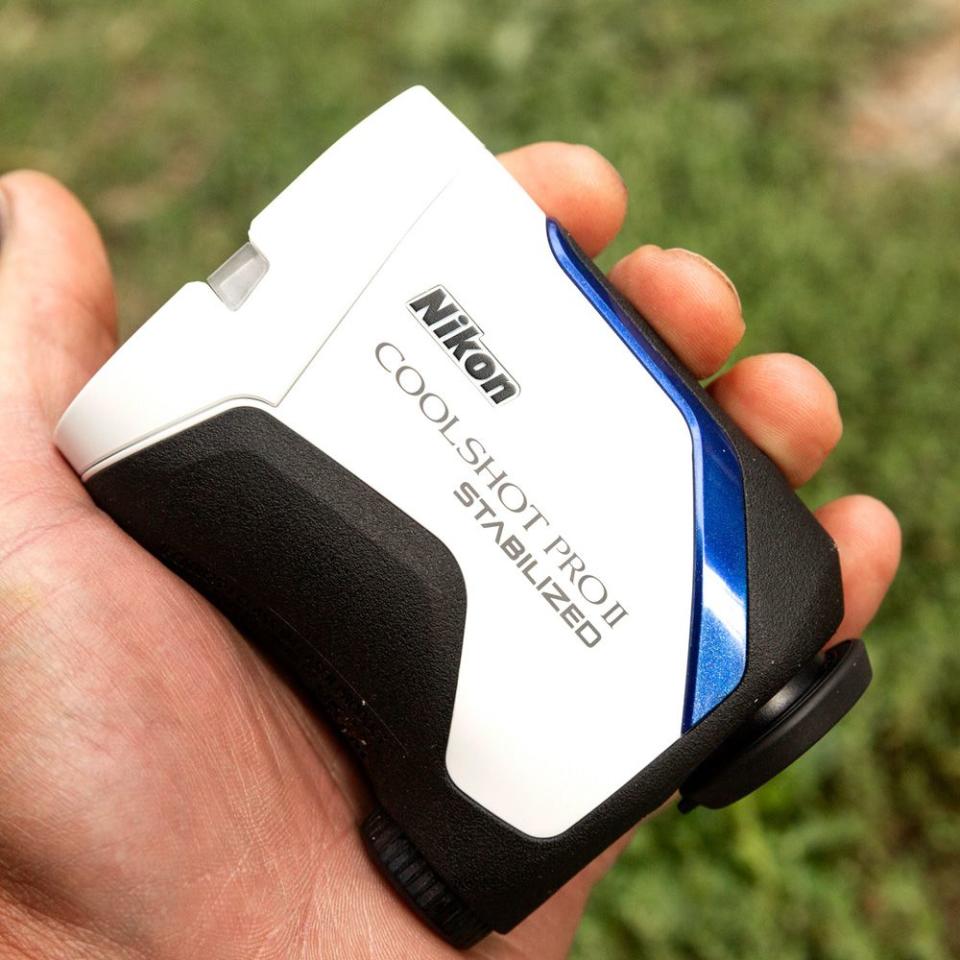
COOLSHOT ProII Stabilized Rangefinder
amazon.com
$430.99
RX-FullDraw 4 Rangefinder
Because arrows fall rapidly after a certain distance, bowhunters and archers need accurate short-range readings. Most practice at 100 yards or less and rarely shoot much farther than 70 yards. Similarly, shooting uphill or downhill can drastically change a shot’s trajectory (gravity has less of an effect as you move toward either extreme), so angle compensation is a must-have feature.
Leupold’s RX-FullDraw 4 is one of a few range finders built with the archer in mind. It features not only angle compensation, but also a near range of 6 yards and half-yard accuracy out to 175 yards. The maximum range is an impressive 1,200 yards, which means it can do dual duty into rifle season or other distances far past bowhunting requirements.
The main drawback with this range finder is cost. Usually, archery hunters can get away with using cheaper, lower-capacity options that cost less than $100, but serious bowhunters will appreciate the added features.
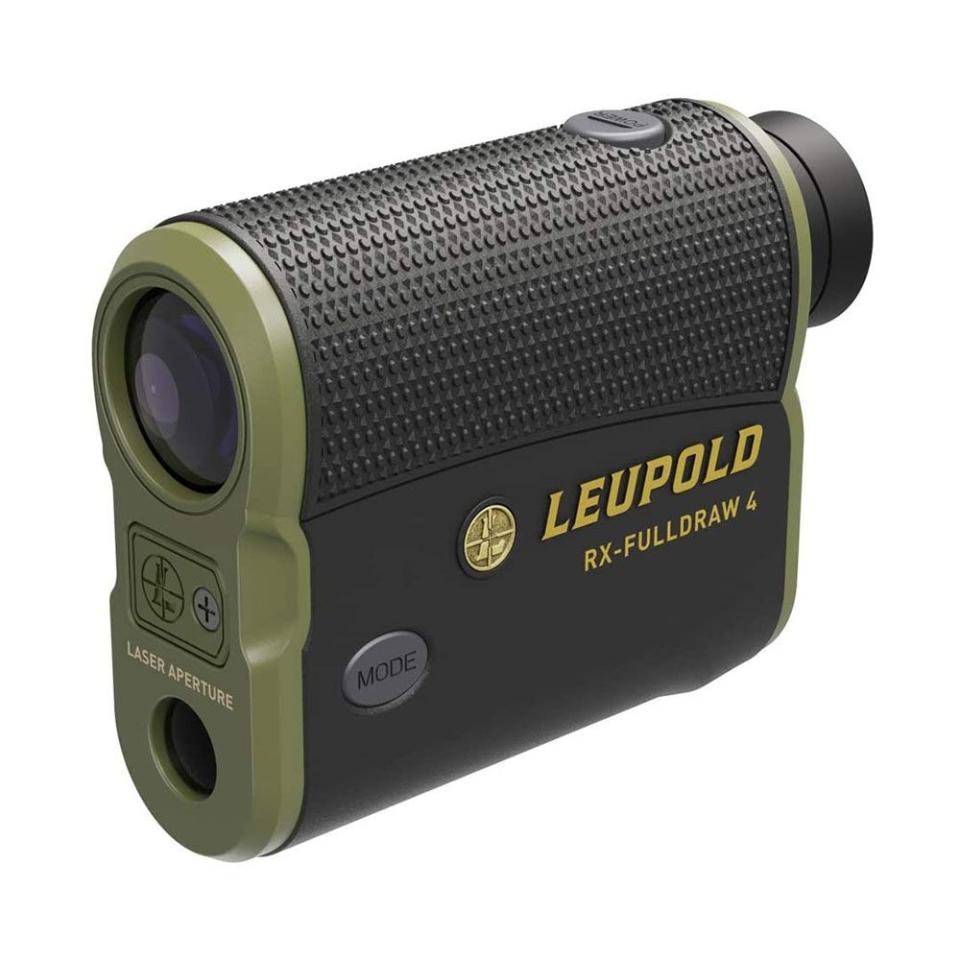
RX-FullDraw 4 Rangefinder
amazon.com
$349.99
Rangeguide 10x32 Binoculars
Most rifle hunters know the drill. Scan the field with your binoculars. Find your quarry. Put the binos down and pull out the range finder to see how far away the animal is.
Range-finding binoculars allow you to do all of that without having to swap optics. The Rangeguide binoculars from GPO are on the high end for binoculars, but they put impressive range-finding capabilities into a high-quality, magnesium-bodied binocular for a single, quality optic that replaces two.
The 32mm objective lens size is a bit smaller than average for hunting binos, but at 24 ounces they’re light despite having the rangefinding tech built in.
I have also tested GPO’s 10x50 rangefinding binos, and while they provide incredible viewing, the larger size wore on my neck after long days hiking with the binocular harness.
The lenses here are made with high-quality European glass that allows lots of light in (also referred to as high light transmission) which is great for the low-light situations like dawn and dusk.
The 3,000-yard-plus range is impressive, and the Rangeguides have all of the features you want in a range finder, such as angle compensation, a bright, adjustable readout, scan modes, and some welcome surprises like temperature readout for long-range shooting adjustments.
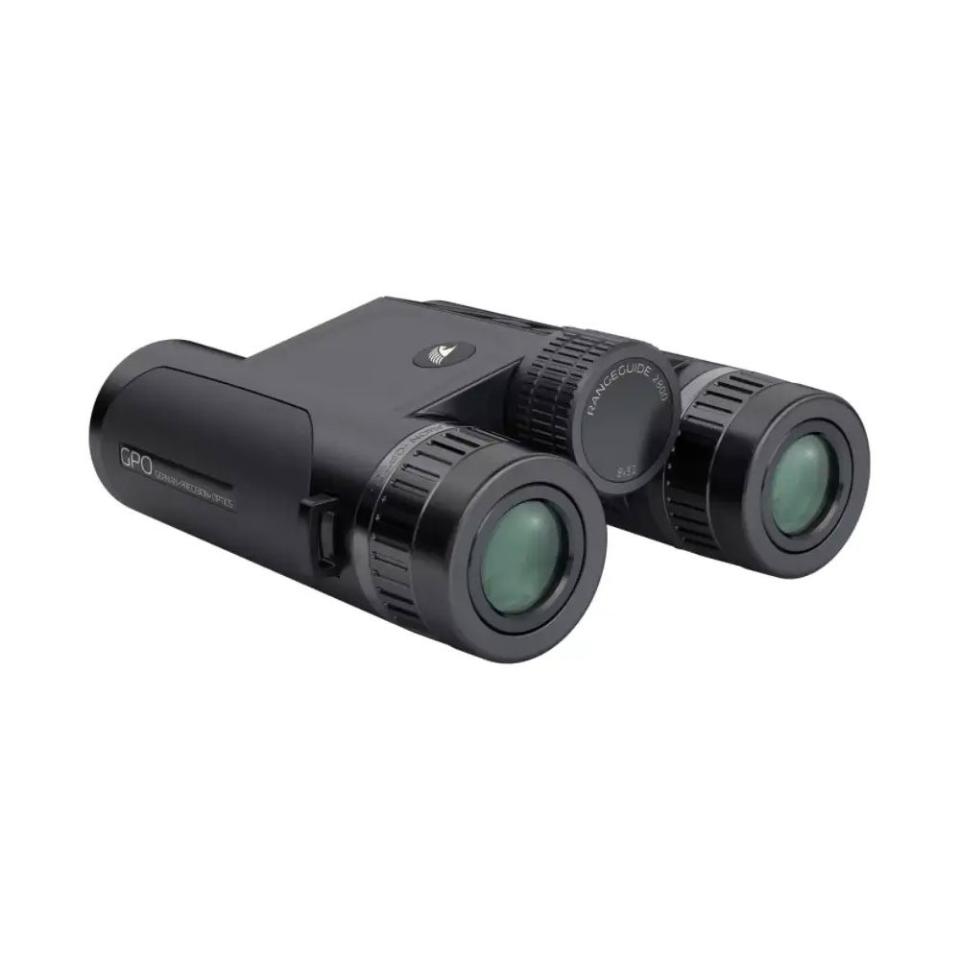
Rangeguide 10x32 Binoculars
opticsplanet.com
$1199.99
Kilo 1000 BDX Rangefinder
Sig Sauer’s Kilo features its innovative BDX (Ballistics Data Exchange) system which uses Bluetooth to allow communication between range finder and riflescope.
When properly paired, the range finder will communicate distance to the scope, displaying an LED holdover dot accurate to your rifle, caliber, and ammunition.
Even taking away the BDX functionality, there are more expensive versions with expanded ranges. So why feature this lower-end model? While it has a stated maximum range of 1,000 yards, in personal use I have ranged rocky hillsides as far as 1,200 yards. The 20-millimeter objective lens is on the small side, but the coated glass does well in low light and presents a high-contrast image.
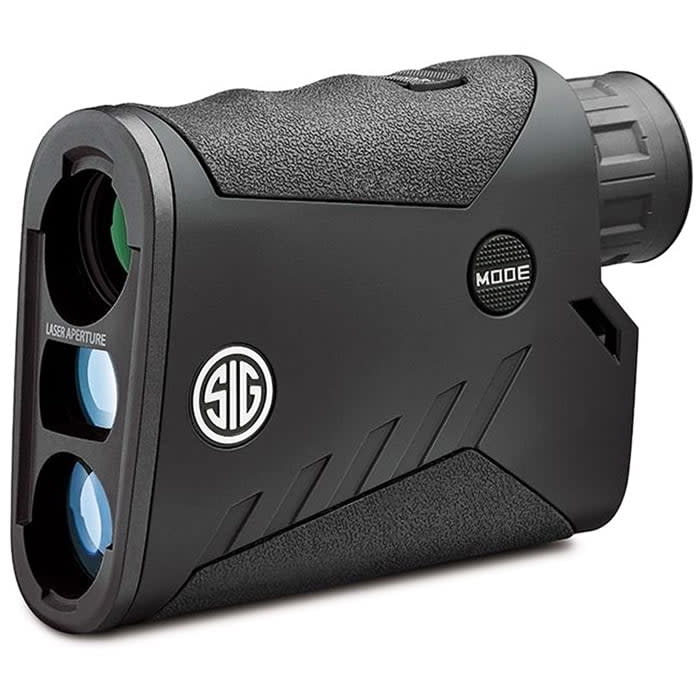
Kilo 1000 BDX Rangefinder
walmart.com
$149.99
If You’re Focused on Your First or Next Range Finder, These Tips From Expert Justin Park Are Worth a Look.
Is there a range finder that can be used for both hunting and golfing?
Most rangefinders can be used interchangeably for either golf or hunting. The basic functionality is the same across models and they share many of the same special features, such as slope angle compensation.
One of the most obvious differences between the two kinds is color. Golf range finders tend to be white, while hunting rangefinders are often darker colors or camouflage.
If you don’t need a rangefinder for both sports, you may as well get one designed specifically for your sport, but if you both golf and hunt, almost any range finder can do double duty. In that instance, just be sure that whichever model you choose has enough range for rifle hunting, as golf rangefinders don’t need to be effective at ultra-long distances.
Should I look for a range finder with modes like scan or fog mode?
Scan modes usually operate by holding down the range button and quickly updating the distance readout as you move the crosshairs to different objects. This is a neat feature and can be a good way to quickly assess the distance of objects in an area around you when, for example, setting up behind a blind when archery hunting.
While scan is nice to have and doesn’t overcomplicate the interface since you just hold the button down to activate, it is much less important to me than optical clarity and angle compensation.
Fog modes attempt to adjust for the problem that can sometimes arise in foggy conditions where a laser rangefinder returns shorter readings due to fog interference. If you hunt or golf in frequently foggy areas, you may want to prioritize a unit with this feature, but I personally have never needed it. Often if it is foggy enough to confuse a rangefinder, it’s too foggy to spot animals anyway.
How long should a rangefinder last?
A rangefinder should be functional as long as you need it to be, provided you take care of it and don’t let battery power components corrode (keep it in a cool, dry place when not in use). Battery life for range finders, on the other hand, is not infinite and can vary quite a bit depending on the type and brand of battery, temperatures, and other factors.
Most of the range finders in these picks use the CR2 type of lithium battery, and they give lifespan estimates of around 2,000 range actuations.
For a casual golfer, that amount of rangings should last them years before needing a battery swap. Even archery hunters that practice a lot and are using their range finders several days a week should expect at least one year out of a battery. That said, I always carry an extra battery or two in the field so I’m not eyeballing distances when it matters most.
What is the biggest mistake someone makes when buying a range finder?
Getting caught up in the details. Hunters can get obsessed with gear and creating spreadsheets to compare this jacket or rifle to its competitors. I’m guilty of this from time to time and it can be a useful exercise in moderation.
While features matter in range finders, remember that beyond a few basics you need to get right for your sport, any range finder will do what you need it to do. (It’s worth reiterating that you should get a device appropriate to the distances involved in your sport. Archery hunters and golfers can get away with a lower maximum range in a range finder than a long-range hunter or recreational shooter.)
Most important is to have a rangefinder—any rangefinder—and use it enough to be comfortable when you need it under pressure in the field. Obsessing over features can also push buyers towards more high-tech range finders with more buttons, features, and display items. These are great if you need them and if you use the device frequently enough to know how to read the display properly in crunch time.
But for most hunters and golfers that use a range finder seasonally and infrequently, a simpler, less expensive option is often a better choice. It may have one button and one number that appear in the display, so it is intuitive enough to be used effectively only a few times a year without much practice.
What is ARC or angle range compensation?
You likely have seen rangefinders touting ARC in their product descriptions, but what does it actually do and do you need it? Laser range finders give you a straight-line distance from your device to whatever you point the laser at, which is simple enough. Hunters and golfers then use that distance to gauge the aiming and/or power of the shot they need to take.
However, gravity starts to affect shots differently when you’re shooting steeply down or uphill. An arrow shot exactly perpendicular to gravity (on level ground) won’t need any angle compensation. But imagine shooting an arrow straight up in the air or straight down off the edge of a cliff.
In either scenario, the arrow’s speed may be affected, but gravity won’t alter the trajectory the way it does when shooting on level ground—pulling the arrow down to the earth as it travels away from you.
In those instances where you’re shooting significantly up or down hill, the angle-compensated distance will be shorter than the actual linear distance between you and the target. If you’re shooting a bow at a target that’s 50 yards away but steeply uphill, the appropriate distance to use to aim may be closer to 40 yards when accounting for the angle.
These adjustments can be made informally when the angles aren’t extreme, but it’s not a calculation you can do quickly and accurately in your head, so it’s convenient to have ARC do it instantly within your range finder.
I personally like a rangefinder with ARC that displays both numbers instead of just showing me the ARC number. If I’m used to seeing both, it’s a good reminder to take this factor into account when necessary and seeing both numbers minimizes the possibility that I look at the lone ARC-adjusted number and then make an additional adjustment to that for angle, consciously or subconsciously.
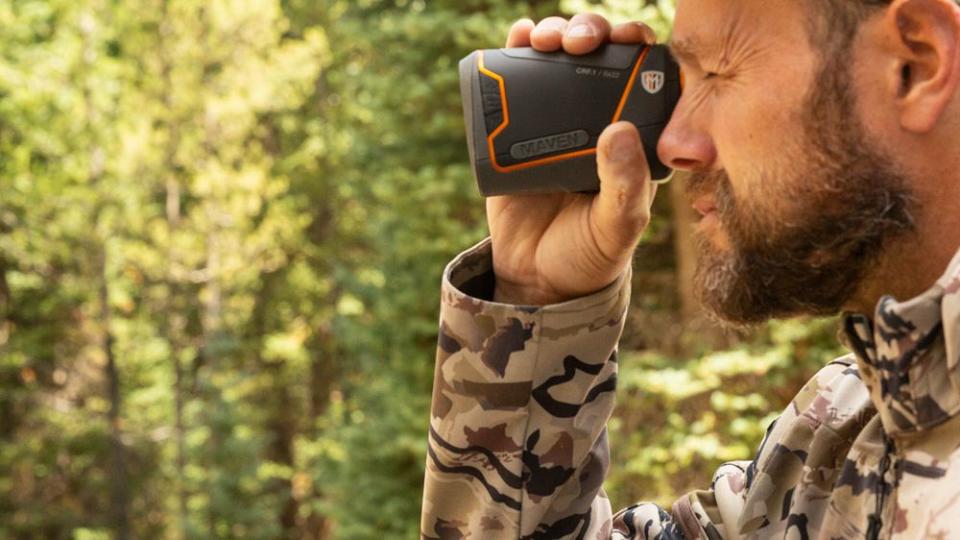
You Might Also Like

